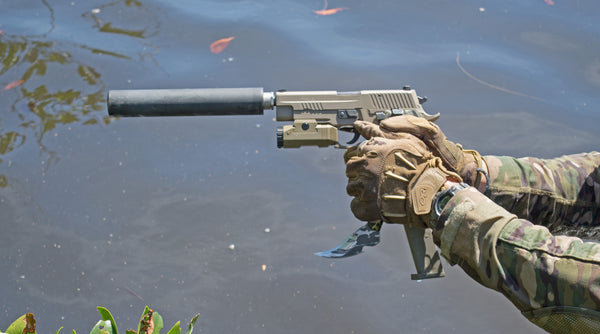Best Combat Pistol
Overview:
It's a question which we industry professionals are often asked and seems ignorant at first... But it's not. There's always a best. However the parameters need to be defined. The best for what? Combat? Hunting? Every-day carry? IDPA? Fun at the range? the list goes on... Well this, in my opinion, is the best "overall" pistol. Shown here in a highly specified, "tacticool", and even Hollywood setup with a Yankee Hill suppressor and 30 round extended magazine is the Sig Saur Scorpion P226 in 9mm. Let me first mention that when I'm going about normal everyday activities I often carry a compact Glock with a lot of personalized work done to it because it's relatively light, reliable, accurate, dependable, highly customizable and has a high magazine capacity. When I need a pistol that is extremely light, small, and can be concealed in minimal clothing I carry a Smith & Wesson M&P 640 in .357 magnum with no lock. But the Sig p226 scorpion is tougher, more accurate, and more finely tuned with many more features and much more attention to detail out of the box. It's more durable? Yes. Like a Glock or S&W revolver it rarely jams but unlike a Glock it won't melt when subjected to heat and flames. (Glock frame's are made out of polymer a space age thermoplastic that will melt when subjected to high temperatures). However unlikely that scenario may be a metal frame is more durable than polymer. A revolver is usually very durable but sacrifices magazine capacity, reload speed, and in the case of a snubnose... accuracy. More accurate than a Glock? Yes. The Glock derives it's accuracy from polygonal rifling in its barrel and although it's very accurate the Sig is a much tighter tolerance, finely tuned, more accurate machine.
Steel Guide Rod and Coiled Steel Recoil Spring:
Those who have used an M9 in sandy environments such as Iraq, Afghanistan, or Africa can attest to the problem of sand caking on the guide rod and recoil spring. There were only two pistols to pass the Army's pistol selection in the 80's, the Beretta M9 (then the 92FS), and the Sig Saur p226. The Beretta was chosen because they were cheaper to produce, but it has two major drawbacks in my opinion: The safety, and the plastic guide rod. The plastic guide rod on the Beretta M9 was designed to flex and return to original form instead of bending if the pistol is dropped with the slide locked back. I cant imagine dropping a pistol hard enough to bend a solid steel guide rod with no other function impeding effects. To me this is a non-issue. The M9 has grooves along the length of its plastic guide rod to catch dirt and debris and keep it from impeding function of the firearm. That may sound like a good idea, and it may look good on paper, but it doesn't work. It does in fact collect dirt and debris, but it just builds up and jams the pistol. Along the same lines as the reasoning behind why I use dry lubricant but that's a discussion for another time and place. The Scorpions steel guide rod and coiled recoil spring doesn't have that problem. There is nowhere for excess dirt build-up to be trapped with a solid stainless guide rod. The coiled recoil spring also maintains its tension much longer than the traditional recoil springs of other manufacturers. The steel guide rod improves reliability and lessens felt recoil. Some of the reasons why we always get rid of the plastic guide rod's in our Glock's as well...
Trigger:
The Sig Short Reset Trigger is a big deal. The pull is light and short, and the break is sharp and clean. The reset requires a mere twitch of the finger and makes this pistol a pleasure to shoot as well as a real contender in combat or for competition shooting involving quick follow up shots. There are not many other pistols that have an excellent trigger requiring absolutely no gunsmithing to lighten the pull or shorten travel out of the box. Furthermore not many pistol owners can do the work required to their own pistols to make the trigger short, light, and crisp. With more local gunsmiths popping up each day it's also becoming exceedingly difficult to find one that knows what they're doing and wont do more damage than good to your firearm. In a Glock the stock trigger pull leaves something to be desired (although it's still not bad when generally compared to average pistols). Again, the Sig SRT trigger is the smoothest trigger I've ever fired on any pistol "out of the box". The fulcrum aftermarket trigger for the Glock measures up nicely when properly adjusted but it's an aftermarket accessory.
Ergonomics:
The ergonomics on the Sig are also on par with other top designs. The controls (slide stop, magazine release, and decocker) are all well placed, easily accessible and work well. The decocker allows the gun to be cocked, then decocked, and carried with a round in the chamber. Once decocked the first pull of the trigger is a heavier double action pull making an accidental discharge less likely, with the follow up pulls being very light. You may wonder why I'm continuously comparing this pistol to the Glock. That's because the Glock has taken the tactical community by storm since its introduction and is a highly respected and well known firearm. For you 1911 guys still clinging onto a pistol design over a century old let me say we're discussing just firearms here. Not taking into account the preference or skillset of the shooter. A 1911 was designed to be hand made and hand-fitted. You may find a $3000 1911 that's an incredible pistol but it's still going to be an inferior design to a P226 based on engineering and moving parts alone. If you choose a 1911 with very tight tolerances because you know how to use it well and its reliable because you use ammo it likes and keep it clean then that's all well and good. I'm not bashing 1911's at all they're beautiful firearms when properly built and maintained, but technology is always improving and when the best 1911 operators tape down their grip safeties in combat that says enough to me about the firearm itself which after all is just a tool. The G10 grips on the Sig are not just stylish, they perform well when it count... They provide a sure enough grip to allow the user to maintain control when slick with mud, blood, or water. There is only one drawback to this pistol I have found and it involves the shape of the grip. When I fire a pistol in an emergency situation or in competition it is often that the first shot or two are fired without using the sights on my pistol. I use a combination of muscle memory, feel of the grip, proprioceptor sensory input, and experience to determine the relationship of the pistol in time and space. This allows at the very least for accurate T-zone shots out to 10 yards. The problem with the grip of the Sig is that it is too ergonomic... Let me explain. It is extremely comfortable and fits the hand so well that it is difficult to judge the precise angle of the firearm by feel alone. If you look at a Glock pistol you will see the sides of the grip are completely flat. This allows the shooter to determine where the pistol is pointing in the horizontal axis by feel, further allowing accurate fire mid draw stroke without using the weapons sight system. I have become able to do this with the Sig, but it has taken much more practice.
Caliber:
Why 9mm? It's cheap, high magazine capacity, and if I run out of mine I can take yours (It's a NATO round and very common). I'm not going to get into the bullet debate here, but I'll weigh my 2 cents. Colonel Coopers 10mm is my favorite pistol round but I'm calling this 9mm the best all around pistol. Simply because there's no magic bullet and I'd rather not get shot with a 9mm any more than I already have. Let me tell you .45 guys... It's no fun, and well placed 9mm rounds are deadly. If I had to stake my life on one pistol only, without knowing the scenario ahead of time, this would be it.
Frame Size:
It's a full size "combat" pistol but still concealable. Depending on the size of your hands a full size pistol offers the most control. For individuals with smaller hands like the woman in the picture below a compact pistol like the Sig p229 might be the best overall pistol, since such individuals often find it difficult manipulate effectively and maintain a proper grip. Full size pistols also feature better accuracy, higher velocity, and less felt recoil. The downside to a full size pistol is that it can be difficult to conceal. And the icing on the cake, if your like me and prefer everything you own to be in earth tones (which you're probably not), you won't have to duracoat this pistol! It comes completely cerakoted in beautiful flat dark earth from factory.





4 comments
Everyone has an opinion their own reasons behind choosing their choice of a tactical pistol. Much of it has to do with what you cut your teeth on coming up or what you were given going to war. The 1911 is still a great firearm but with the higher mag capacities available today one must consider the options available to them. You stated the 9mm is. a viable round and Colonel Cooper’s 10mm certainly superior. All this being said the .45 ACP is still my round of choice in a defense round to this day. Hard ball in this caliber will still do the job it is intended but many defensive rounds available make this round top of the list with me. My FN FNX will shred any target with rounds to spare. It fits close to the body and even with its size does no hinder movement or speed. When I empty all my M4 mags or it jams the FNX with over fifty rounds at hand give a great deal of comfort and sense of security. .45 ACP, easy t find, very manageable recoil and energy out to fifty yards to get the job done.